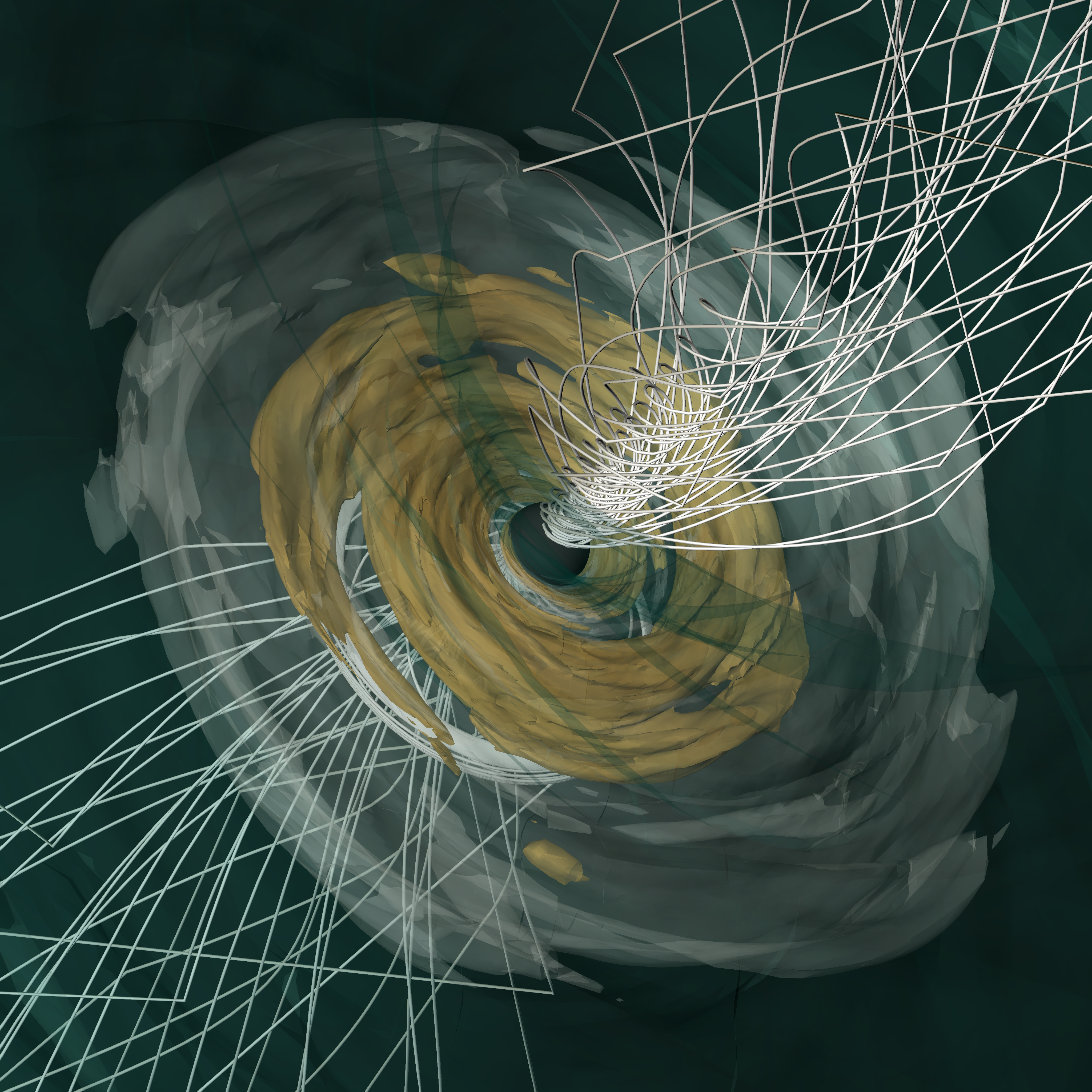The Event Horizon Telescope (EHT) collaboration has published new results that describe for the first time how light from the edge of the supermassive black hole M87* spirals as it escapes the black hole’s intense gravity, a signature known as circular polarization. The way light’s electric field prefers to rotate clockwise or counterclockwise as it travels carries information about the magnetic field and types of high-energy particles around the black hole. The new paper, published today in Astrophysical Journal Letters, supports earlier findings from the EHT that the magnetic field near the M87* black hole is strong enough to occasionally stop the black hole from swallowing up nearby matter.
“Circular polarization is the final signal we looked for in the EHT’s first observations of the M87 black hole, and it was by far the hardest to analyze,” says Andrew Chael, an associate research scholar at the Gravity Initiative at Princeton University, who coordinated the project. “These new results give us confidence that our picture of a strong magnetic field permeating the hot gas surrounding the black hole is the right one. The unprecedented EHT observations are allowing us to answer long-standing questions about how black holes consume matter and launch jets outside their host galaxies."
“Analyzing the structure of the magnetic fields in the vicinity of the supermassive black hole M87* using polarized light is crucial to understanding the nature of the black hole and the hot gas around it,” says Alejandro Cruz Osorio, from the Institute of Astronomy (IA) at UNAM in Mexico City. “The spiral structure inferred in these magnetic fields is consistent with theoretical predictions and suggests that the gas must be highly magnetized, which helps accelerate the material in M87's characteristic jet.”
“The EHT is one of the most important scientific collaborations in the world today. Mexico's participation in this project gives global visibility to our country’s science,” comments Laurent Loinard, from the Institute of Radio Astronomy and Astrophysics (IRyA) at UNAM, Campus Morelia. “It also allows students and young researchers to be immersed in this exciting and vibrant collaboration, involving some of the world's best scientists. It is a truly global collaboration that allows you to interact with people from many horizons. It is a very enriching experience to participate in it.”
A story told with weak and spiraling light
In 2019, the EHT released its first image of a ring of hot plasma close to the event horizon of M87*. In 2021, EHT scientists released an image showing the directions of the oscillating electric fields across the image. Known as linear polarization, this result was the first sign that the magnetic fields close to the black hole were ordered and strong. The new measurements of the circular polarization – which indicate how light’s electric fields spiral around the linear direction from the 2021 analysis – provide yet more conclusive evidence for these strong magnetic fields.
“The signal in circular polarization is 100 times weaker than the unpolarized data we used to make the first black hole image,” says Ioannis Myserlis, a staff astronomer at the Institut de Radioastronomie Millimétrique (IRAM). “Finding this weak signal in the data was like trying to listen to a conversation next to a jackhammer. We had to carefully test our methods to determine what we could really trust.”
 A computer simulation of a disk of plasma around the supermassive black hole at the center of the M87 galaxy. A new analysis of the circularly polarized, or spiraling light, in EHT observations shows that magnetic fields near the black hole are strong. These magnetic fields push back on infalling matter and help launch jets of matter at velocities near the speed of light out. Image Credit: George Wong
A computer simulation of a disk of plasma around the supermassive black hole at the center of the M87 galaxy. A new analysis of the circularly polarized, or spiraling light, in EHT observations shows that magnetic fields near the black hole are strong. These magnetic fields push back on infalling matter and help launch jets of matter at velocities near the speed of light out. Image Credit: George Wong
To perform this careful analysis, the team created several new methods for reconstructing a polarized image from the EHT’s sparse, noisy measurements and tested them thoroughly. “Testing our different analysis methods against simulated data and against each other was critical,” said Freek Roelofs, a postdoctoral fellow at the Center for Astrophysics | Harvard and Smithsonian. In a companion paper, also published today, Roelofs found that when he enforced strong assumptions about the image in his analysis, the data revealed a surprising difference in the left- and right-handed light across the ring we see. However, other methods that made weaker assumptions did not see this difference. “Working together to see what we can and cannot squeeze out of our data has made this project incredibly exciting and rewarding,” Roelofs said.
The team performed different tests on the data, and all of them found unambiguous evidence that circularly polarized light exists close to the event horizon. In the end, because the EHT’s measurements of circular polarization were much weaker than the earlier datasets, the team was unable to come up with an unambiguous image of the ‘handedness’ of the spiraling light. Instead, the team was able to determine that the circularly polarized or spiraling part of the light could only be a small fraction of the total light making up the black hole image.
The team applied this measurement to test different theories for the shape and movement of the plasma and magnetic field around the black hole, including a set of state-of-the art supercomputer simulations. “The circular polarization observations bolster our earlier results indicating that the magnetic fields are strong enough to push back on the infalling matter and help launch the strong jets of plasma we see extending throughout the M87 galaxy,” said Angelo Ricarte, a postdoctoral fellow at the Black Hole Initiative at Harvard University. Abhishek Joshi, a graduate student at the University of Illinois, added, “It’s wonderful to directly compare our simulations to these cutting-edge observations. Together, they paint a picture of a chaotic, violent environment just outside the event horizon, where magnetic fields, gravity, and hot plasma strongly interact with each other.”
Although the existing EHT data are not sensitive enough to determine the structure of the black hole’s circular polarization, the team has high hopes for the future. Ongoing analysis of more recent EHT datasets could yield better detections of this signal, which could answer further questions about whether matter-antimatter pairs of particles make up any of plasma outside the event horizon and how they are accelerated to velocities close to the speed of light.
“Working with these pioneering observations was really challenging, but it trained us well for the future,” said Svetlana Jorstad, a senior research scientist at Boston University. "The EHT is growing rapidly, with new telescopes and better technology at all our sites, giving us a more sensitive and detailed set of data to work with. It’s exciting to contemplate how much better our results could get in just a short time.”
More information about the Event Horizon Telescope
The EHT collaboration involves more than 300 researchers from Africa, Asia, Europe, and North and South America. The international collaboration is working to capture the most detailed black hole images ever obtained by creating a virtual Earth-sized telescope. Supported by considerable international investment, the EHT links existing telescopes using novel systems, creating a fundamentally new instrument with the highest angular resolving power that has yet been achieved.
The individual telescopes involved are: ALMA, APEX, the IRAM 30-meter Telescope, the IRAM NOEMA Observatory, the James Clerk Maxwell Telescope (JCMT), the Large Millimeter Telescope (LMT), the Submillimeter Array (SMA), the Submillimeter Telescope (SMT), the South Pole Telescope (SPT), the Kitt Peak Telescope, and the Greenland Telescope (GLT).
The EHT consortium consists of 13 stakeholder institutes: the Academia Sinica Institute of Astronomy and Astrophysics, the University of Arizona, the University of Chicago, the East Asian Observatory, Goethe-Universitaet Frankfurt, Institut de Radioastronomie Millimétrique, Large Millimeter Telescope, Max Planck Institute for Radio Astronomy, MIT Haystack Observatory, National Astronomical Observatory of Japan, Perimeter Institute for Theoretical Physics, Radboud University, and the Smithsonian Astrophysical Observatory.
Mexico in the Event Horizon Telescope
The Alfonso Serrano Large Millimeter Telescope, located on the Sierra Negra volcano in the state of Puebla, is one of the radio wave observatories that participates in the Event Horizon Telescope. It is maintained by the National Institute of Astrophysics, Optics and Electronics (INAOE) and the University of Massachusetts. The Mexican community that participates in the EHT collaboration includes at least 10 people in foreign or national institutions, such as the IRyA and IA, both at UNAM, and the INAOE.
EHT Collaboration contact in Mexico
Alejandro Cruz Osorio
Instituto de Astronomía, UNAM
Ciudad de México, México
Laurent Loinard
Instituto de Radioastronomía y Astrofísica, UNAM
Morelia, México
Media contact in Mexico
René A. Ortega Minakata
Instituto de Radioastronomía y Astrofísica, UNAM
Morelia, México
Brenda Arias Martín
Instituto de Astronomía, UNAM
Ciudad de México, México
Text: EHT Collaboration, adapted by IRyA UNAM
International EHT Collaboration contact
Andrew Chael
Princeton University
Princeton, NJ, USA
Email:
Svetlana Jorstad
Boston University
Boston, MA, USA
Email: jorstad@bu.edu
Abhishek Joshi
University of Illinois
Champaign, IL, USA
Email:
Ioannis Myserlis
Institut de Radioastronomie Milimétrique (IRAM)
Granada, Spain
Email:
Angelo Ricarte
Harvard University
Cambridge, MA, USA
Email:
Freek Roelofs
Center for Astrophysics | Harvard & Smithsonian
Cambridge, MA, USA
Email:
Geoffrey C. Bower
EHT Project Scientist
Academia Sinica Institute of Astronomy and Astrophysics
Hilo, HI, USA
Tel: +1 (510) 847-1722 (cell)
Email:
Mariafelicia de Laurentis
EHT Deputy Project Scientist
University of Naples Federico II
Naples, Italy
Email:




